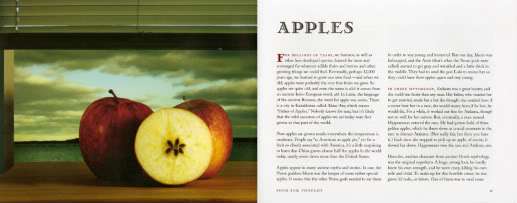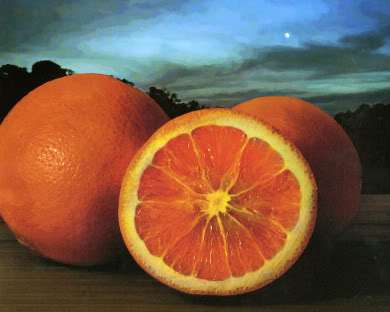
FOOD FOR THOUGHT: THE STORIES BEHIND THE THINGS WE EAT,
by Ken Robbins (Roaring Brook Press, 2009), ages 6+, 48 pp.
What do you think is the most important food in the world?
Besides chocolate, that is ☺.
In his sumptuous new book, Food for Thought: The Stories Behind the Things We Eat, Ken Robbins serves up a thoroughly mouthwatering, fascinating feast of culinary history, myth, folklore, trivia, and nutritional information about nine foods widely available in supermarkets across the country: apples, oranges, potatoes, tomatoes, grapes, mushrooms, corn, bananas, and pomegranates.
Though some may find the selection eclectic, I like that Robbins includes foods most kids in America probably eat on a regular basis, maybe even take for granted — and then piques their curiosity with provocative infobits and absolutely stunning photographs. Then, while he’s got their attention, he also rhapsodizes about mushrooms and pomegranates (not exactly lunchbox fare), tempting them just enough to whet their appetites (pizza lovers may not even need a mushroom nudge).

As Robbins states in his brief introduction, “Every kind of food has its story.” This includes where these foods originated, how they are grown, processed, and consumed, how they’ve inspired writers and artists, what part they’ve played in America’s history, and even their political and economic implications in a world whose population will likely double by the year 2050.
I like knowing that an apple helped cause the fall of Troy, that Brazil produces the most oranges (but most of its OJ is not drunk at breakfast), and that bananas are so full of essential nutrients that it would be possible to “eat nothing else and still survive in good health.” Good stuff to know if you’re ever banished to a desert island and allowed to take only one kind of food! And now, I feel even more indebted to the Native Americans, who kept the Colonists from starving with their gifts of corn.
One might ask, why do we need to read this book, since the information is widely available on the internet? First, the gorgeous photographs are worth the price of admission alone. Life-size, and larger-than-life-size close-ups of the fruits and vegetables, set against various skyscapes, some dark and cloudy, some sunny, provide a unique opportunity for aesthetic appreciation. It’s no mistake that some of the world’s greatest paintings are still-life studies; through Robbins’ discerning lens, we are invited to reconsider and pore over the beautiful texture of orange peel, the juicy sheen of citrus chambers, or the curious, almost comic shapes of heirloom tomatoes. Food can nourish on so many levels.

Also, each fruit or vegetable is discussed via several pages of text, with additional photographs showing their sources — a vineyard, a potato field, an apple tree. Because only 2% of today’s Americans live on a farm, fewer of us know what these foods actually look like in their natural state. Robbins never forgets who his audience is, either — kudos to him for two photos of french fries (both with ketchup, of course), along with pizza, apple bobbing, a mushroom fairy ring, as well as sit-up-and-take-notice mention of popcorn, cornflakes, banana splits, and apple pie.
Food for Thought, suitable for ages 6 and up, is perfect for National Fruit and Vegetable Month. The bountiful mixed platter of information contains just enough choice facts to intrigue young palates, enabling them to look at these common foods in a new way.

And the most important food? Corn. It feeds billions of people worldwide and without it, many would starve to death. Did you already know that?
Today’s Nonfiction Monday Roundup is at Tales from the Rushmore Kid.
*Photographic spreads posted by permission, copyright © 2009 Ken Robbins, published by Flash Point, an imprint of Roaring Brook Press. All rights reserved.

Looks like a tasty read–and the photo spreads are gorgeous!
LOL about pomegranates not being lunchbox food. Ha, can you imagine?!?
LikeLike
YUM! This will make a perfect addition to my nonfiction collection.
And surprisingly, I had a child who brought pomegranate jewels for snack when they were in season last year! Lucky kid to have someone who would prepare such a snack, eh?!?!
LikeLike
The photos have to be seen in person to be fully appreciated. Ken Robbins’ work is amazing.
I wondered at first about the inclusion of pomegranates (which I, personally, have never tried) — and thought perhaps Robbins wanted to “sneak in” something exotic along with the familiar. They certainly are beautiful in their own right, and since they originated in the Middle East (first grown in Iran), it’s a good multicultural angle, in keeping with the demand for more info about the region.
LikeLike
Pomegranate jewels — will have to try some soon! They really do look pretty.
LikeLike
“…pomegranates (which I, personally, have never tried)…”
Oooh, I see a blog entry in the making! Seriously, you should totally try ’em! And photograph the experience for public consumption.
LikeLike
Good idea, Melodye. I really should broaden my horizons by trying several new fruits and veggies. 🙂
LikeLike
Pomegranates are fun to share. One word of warning, though: Napkins. Lots of ’em. Or maybe a bib. (They’re fruit-juicy delicious, but can stain your clothes.)
If you decide to post an entry about pomegranates, will you please send me a PM or email? I’ll be away from internet access for quite some time, and I wouldn’t want to miss out on the fun. I’ll look forward to seeing it when I get back…
LikeLike
Sure thing, Melodye. I’ll miss your posts while you’re gone, though . . .
LikeLike
The book looks like a feast for the eyes! *makes note to track down a copy*
LikeLike
Corn is one of my favourite foods. My MIL, who was from Roumania, said that people from her country thought of corn as “animal feed.” (!)
LikeLike
I’m sure you’ll enjoy it — especially the mythology and folklore tidbits.
LikeLike
Even if not directly consumed, corn is vital in the food chain — feed the animals, eat their flesh or milk. I love cornbread and corn tortillas :), and the other night I had a delicious corn souffle!
LikeLike
There are other foods besides chocolate? Mmm. I’ll have to check into that. 🙂
LikeLike
Startling, isn’t it? 😀
LikeLike
I can see why you’d love this book–those food photos are gorgeous. And the banana thing–that’s why Gilligan and the gang lasted so long on the island. 🙂
LikeLike
LOL! Good point. Never thought of that :D!
LikeLike
It looks beautiful.
And it makes me very happy to read that about bananas. I’m a picky eater, but I like me some bananas. I’m surprised to hear it (aren’t they sugary? Or do I have that all wrong?) – but happy.
Jules
7-Imp
LikeLike
Yes, they’re sugary, and have a high glycemic index. Still, on a desert island, who’s checking?
LikeLike
Although I did not know for sure, corn was definitely among my guesses for the “most important food”. 🙂
So, when do Brazilians drink their OJ?
Sounds like a lovely book, although I can easily imagine many MANY foods being interesting enough to include, including a whole bunch of other common veggies and fruits, as well as, say, wheat and rice as common (American) grain representatives (aside from corn). I suppose, it being targeted at kids, he didn’t want to overwhelm anyone.
LikeLike
It would be interesting to find out how he chose these particular nine — mostly fruit. Maybe his next book will focus on grains :).
As for the Brazilians, apparently they like their OJ during the rest of the day, but hardly ever at breakfast.
LikeLike
Oh, I’m so glad this posted – the comment window seized up after I clicked – I couldn’t even copy/paste to save my comment, and so I just closed the window and gave up, figuring my comment wasn’t that crucial. But still – nice to know it went through. And thanks for the OJ insight!
LikeLike
Food for thought
Jama, thanks for sharing this book. I love stories behind food and recipes. They exist in our own families. If we just take the time to ask our mothers questions around the dishes they make we’d have a family history.
I’ll have to get this book. It looks fun and good for “table talk”!
LikeLike
Re: Food for thought
I agree — stories centered around food make for fascinating and delicious family histories. This is my first Ken Robbins book; I’m definitely going to have to see more of his work.
LikeLike